Cape to Cairo Journey:
Pages to Explore:
Blog Catagories:
Photo of the day








Home | About Us | Safaris & Photographic Trips | Blog | Contact Us | Sitemap | Disclaimer
The Essence of the Journey!
We would like to do this trip to experience new cultures.
We would like to understand what makes African people pure.
What are their spiritual beliefs, understandings?
How does the spiritual world we know exist to them?
What can we learn from them?

Jul 31 12
Silverbacks & montane rainforests …
Bwindi Impenetrable National Park ŌĆō Uganda
Diane Fossey, another doyenne of conservation, opened up the world of Gorillas to the universe.┬Ā Although a fiery and controversial character, her grit and determination was arguably what was necessary in this tough part of Africa to help save the Gorillas. Her colourful character has left behind a colourful place.┬Ā Narrow roads, singing school children from nearby villages, smiling rangers and guides, ŌĆśyou are most welcome to Bwindi ŌĆ”ŌĆÖ says Kenneth the manager at Ruhija.
Research is ongoing, but tourism has also has also become a crucial part in the conservation of the species.┬Ā To trek with the Gorillas in Rwanda cost 750$ per person.┬Ā In Uganda, it is cheaper at a mere 500$ per person.┬Ā We based ourselves at Ruhija, and here there are 2 family groups that are used daily for tourism.┬Ā There is a third group (the Kyaguriro group) which although principally a research group, also has the ŌĆśoverflowŌĆÖ tourist group visit them.┬Ā We had not pre-arranged permits, as we were unsure of our timing ŌĆō thank goodness.┬Ā This visiting group is therefore generally smaller.┬Ā On the day I chose to track the gorillas, there were 21 tourists, which from this camp alone (there are 2 other ŌĆśtracking campsŌĆÖ in Bwindi) translates to 10 500$ (R90 000)/ day.┬Ā For three camps R270 000/day or R8.1 million per month, not too shabby.┬Ā Granted this is peak tourist season.
So as Nicolai & Danica posed the question, Was it worth it?
The Kyaguriro group comprises 18 individuals, one silverback named Rukina and 5 baby gorillas, under 3 years old.┬Ā They are also the furthest away from the camp at Ruhija.┬Ā In eager anticipation, we arrive at Uhringa at 07h30, eager to get going.┬Ā The briefing follows around 08h30 with the paperwork out the way, and weŌĆÖre in the primary equatorial highland forest, ten minutes thereafter.
There are 2 Swedish 2nd year students that have been volunteering in Uganda the last 5 weeks, David our guide, Amos another tracker and an armed ranger that complete our group.┬Ā I enquire with our armed ranger the need for his AK47.┬Ā He is quick to remind me that there are 70 remaining forest elephants that have a bad reputation.┬Ā David adds that should one come across a lone Silverback, they too can be quite aggressive.┬Ā My twisted imagination feels that it is more likely for the odd DRC bandit strays across the border, or perhaps ŌĆ” a band of poachers.
The rain forest is unpredictable.┬Ā The slopes are steep and often muddy.┬Ā When one hikes, one could wish for longer mountain type ridges.┬Ā Instead one finds, conical peaks which mean that you need to go up, and then down, often.┬Ā The air is humid, and perspiration covers your face in minutes.┬Ā This is the cool, dry season and June to September are the best month to track gorillas in Bwindi.┬Ā This morning is particularly misty and damp, but thankfully there is no rain.┬Ā Now and again the sun shines, but mist and clouds win the day.
This group is the furthest out, weŌĆÖre 3 hours into the trek, and are informed by radio that the other two groups have seen the gorillas and are on their way back.┬Ā It is great being in the rain forest, however, we need to come back to Ruhija the same way, and we have not yet found the gorillas.
Bwindi is one of the richest forests in East Africa for birds (350 species), butterflies (310 species) and trees (324 species).┬Ā Bwindi also has 120 species of mammals and 10 species of primates.┬Ā Some of these species are only found in the highland forests of south-western Uganda, eastern Congo, Rwanda and Burundi.┬Ā This is known as the Albertine Rift.┬Ā Bwindi has 23 birds endemic to the Albertine Rift and 10 trees endemic to Uganda.┬Ā Half of the worldŌĆÖs population of critically endangered mountain gorilla occur in Bwindi.
ŌĆ£WeŌĆÖre half an hour awayŌĆ”ŌĆØ David tells us after brief communication over the radio with the researchers.┬Ā ŌĆ£They are with the gorillas ŌĆ”ŌĆØ he says boosting our spirits.┬Ā My left boot had just sunk knee deep into a bog, but as we climbed the next steep tree covered slope, we came across gorilla nests.┬Ā I was surprised to note that they were not far off the ground.┬Ā I guess this makes sense, considering the average Silverback may weigh over 200kg.┬Ā Gorillas defecate at their nest sites and judging the age of the faeces is the easiest way to know how old the sites are.┬Ā ŌĆ£3 daysŌĆØ came the answer from David.┬Ā They make fresh nests daily and seldom forage more than 1 kilometre a day.┬Ā We had seen a lot of elephant dung, but this was our first encounter with gorilla excrement, unsurprisingly very human like.
At the top of the ridge, we met a research assistant, ŌĆśjust over the hillŌĆÖ was the comment.┬Ā The group became quiet with anticipation, edging closer.
As we craned our necks forward, our eyes scanned the slope for the familiar shape that books and movies had shown us.┬Ā A furry black shape moved into a clearing from the cover of a thousand of morning glory plants.┬Ā Quite unperturbed with our presence 50 metres away.┬Ā We crunched and snapped our way closer, now with facial masks covering our mouths and noses.┬Ā There are no paths where gorillas forage and I now understood why our party had machetes.┬Ā You move forward more in hope than certainty, one knows that there is earth, you just cannot see it.
Four stubby digits peel back a ranch of undergrowth, a one year old is too curious.┬Ā For a few minutes she stares into our eyes, in search of answers, then there is a tug on her shoulder and her mother carefully moves her off, as though adjudicating the time spent with us as sufficient.┬Ā We can see the conical shape of the SiverbackŌĆÖs head behind the bush, but sitting down contentedly, munching, we do not have a clear view.┬Ā Although a group of eighteen, as yet we can only make out 7 shapes.┬Ā The secondary growth where they are eating is not strong and a junior gorilla brings a young shrub cracking to the ground, his weight too heavy for the bush.┬Ā The Silverback edges further down the slope and we follow slowly, moving into the space the female and her baby were minutes ago.┬Ā The whole area feels energized.┬Ā These gentle creatures are special.
Rukina is now looking at us, head on.┬Ā Without stopping the chewing, his bloated stomach tells us that he has eaten most of the 20kg he eats a day.┬Ā Although gorillas may look ŌĆśfatŌĆÖ it is a direct result of the proportion of plant matter they eat on a daily basis.┬Ā As a result it is very difficult to tell when females are pregnant in the field.┬Ā Gorillas do not eat meat, although they have been known to take on the odd ant, as well as dead infants.┬Ā Unlike chimpanzees, gorillas do not hunt.
Now and again the group gives off gentle grunts; the researchers which are now accompanying us reply with poor imitations of the grunts.┬Ā This is supposed to make the gorilla group more relaxed and to let them know that ŌĆśwe come in peace and mean them no harmŌĆś.┬Ā With these vocal acknowledgements, the group is kept under wraps by the authorative silverback.┬Ā Other than the odd branch being broken or snapped off, there is little other sound coming from the group ŌĆō black billed touraco calls out, and then flies past our group.
An immature black back (immature silverback or young male) has made his way from the valley floor up towards the group on the ridge.┬Ā With our stare fixed on the silverback 13m away and one of his females with a baby, we hardly noticed the blackback.┬Ā 10, 9, 8 ŌĆ” 2m away from me.┬Ā WeŌĆÖre supposed to stay 7m away from gorillas at all time, but such is the level of this habituated group.┬Ā Even more interestingly, the blackback did not walk off, but instead stayed 2 m away, yanking leaves off the brush, occasionally glancing back over his shoulder directly at me.┬Ā I felt a yank at my shoulder ŌĆō David the guide asking me to move back slowly.
There we were 4 youngsters in the group and we continually saw them peeking at us, okay – staring.┬Ā It was not rude.┬Ā They seemed to be reaching out.┬Ā Could they see things that we could not?
Time flew, and we got the ŌĆśtwo minutes, final pictures pleaseŌĆÖ call.┬Ā Only an hour is allowed per visit.
Whilst we were in their presence we did not speak much, we did not need to.┬Ā All was understood.
I had been privileged.┬Ā Thank you.



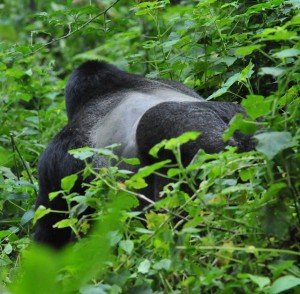
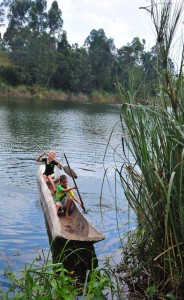

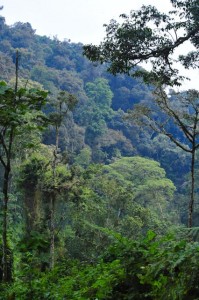
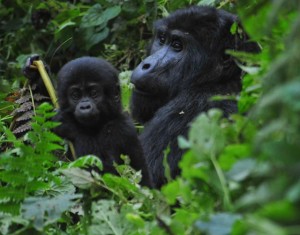
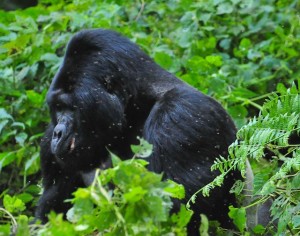
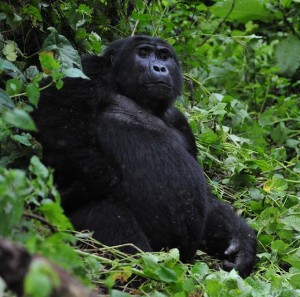
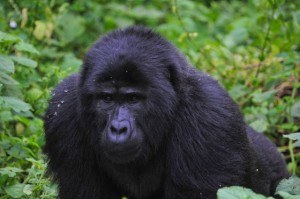
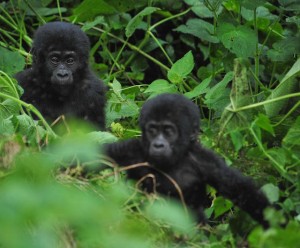


Awesome!!!!!!What more can one say?
Hi Roger, thanks for the boost. The gorillas were particularly rewarding and awe inspiring. It has been great to be able to share thoughts and experiences with you folks. Love to all
Roger beat me to it.. all I can say is “AWESOME”
Jo Brad, thank you for your kind wishes, we need the boost they give us as we move north into Africa. By the way, did you manage to pick up our bikes from the Cape? Love to Caroline, Matt & Amy, miss you guys …
Everyday part of my morning ritual is to check the blog to see all this “out of this world” and insanely awesome stuff you guys are experiencing and seeing….just wonderful.
Keep going……
Much love
Lucia
(P.S. You are inspiring me to do a cross -country US trip, not quite the same but hey still an adventure)
Hi cuz, that is awesome, I’m really glad that you will be doing your cross US trip and seeing more of this awesome world we live in. Thank you for your kind wishes and thoughts, they put fuel in our tanks and keep us going…. Love from us all
Hi Marcelo and family,
what an amazing experience, lucky you… I just hope the money they make is used for the gorillas and their protection..
we have been on summer holiday for a long time in Italy and France-Corsica so now we have to catch up with all your news..
Anke and family
Hi Anke,
Good to hear from you. Italy and France – how wonderful! I am sure you had a great holiday. We have not been to either, YET! Tembe and Christmas seems so long ago, as does all of South Africa and home. Money and wildlife and humans – a real conundrum. We send love to you and the family,
Celeste, Marcelo, Danica and Nicolai
Sooooo glad you saw the gorillas. an awesome experience. did Cel go too? The soldier and gun have norhing to do with elephant, there was tourist/bandit trouble. We went form Diane Foseey’s camp and gunmen took out a whole overland truck at the entrance, hence your happy armed guard. Nothing like walking on bamboo mat for hours and not solid ground!
Hi Loni,
Course I went, wouldn’t miss it. Had the same looong trek and stunning gorillas. Our ‘gunman’ looked unlikely to be able to take any shots with accuracy but I have found it somewhat alarming to see so many guys toting guns so casually not only in the forests but all over the cities – as if it were normal! It begs the question as to what humankind is up to??? And people still think of SA as a ‘dangerous destination’! We tracked down Dianne Fossey’s book which Danica had started reading en route somewhere but had to return, and gave it to her for her birthday. Unfortunately, Marcelo once joked (secret newsflash – never once joke with kids as they never forget or let you forget) about Dianne Flossy – and of course, it has now stuck.
Love to you and Denise, and Mum and Dad, and kitty and fishie,
Celeste and familia